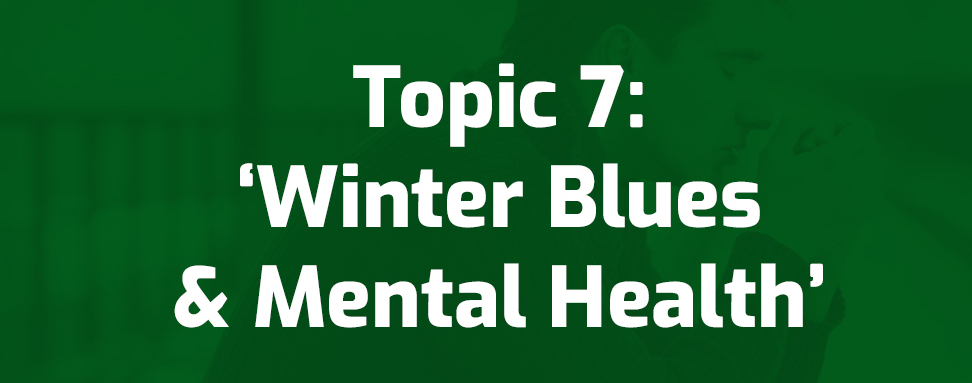Reflex team join A.D.V.I.C.E Group
Sales Director, Lisa Spong and Business Development Manager, Charlie Atkins join A.D.V.I.C.E Group
By Peter Lowe
Topic: Winter Blues hosted by Dyer & Butler/Ganymede.
Often the change in seasons to the winter can leave you feeling tired, tearful, or grumpy. And if you experience this, then you’re not alone. While research suggests around 3% of people in the UK are diagnosed with full-blown seasonal affective disorder (SAD), there’s also a milder form, which is much more common and can result in low mood. SAD, or ‘winter blues’, affects 21 % of the population in the UK, explaining why so many of us are left feeling down through the colder months.
Seasonal affective disorder (SAD)
Seasonal affective disorder (SAD) is a type of depression that comes and goes in a seasonal pattern. SAD is sometimes known as "winter depression" because the symptoms are usually more apparent and more severe during the winter.
The exact cause of SAD is not fully understood, but it's often linked to reduced exposure to sunlight during the shorter autumn and winter days. The main theory is that a lack of sunlight might stop a part of the brain called the hypothalamus working properly, which may affect the:
• Production of Melatonin – melatonin is a hormone that makes you feel sleepy; in people with SAD, the body may produce it in higher than normal levels
• Production of Serotonin – serotonin is a hormone that affects your mood, appetite and sleep; a lack of sunlight may lead to lower serotonin levels, which is linked to feelings of depression
• The body's Internal Clock (Circadian Rhythm) – your body uses sunlight to time various important functions, such as when you wake up, so lower light levels during the winter may disrupt your body clock and lead to symptoms of SAD
Symptoms of SAD
The symptoms of seasonal affective disorder (SAD) are similar to those of normal depression, but they occur repetitively at a time of year - they usually start in the autumn or winter and improve in the spring.
The nature and severity of SAD varies from person to person. Some people just find the condition a bit irritating, while for others it can be severe and have a significant impact on their day-to-day life.
Signs that you may be depressed include a persistent low mood, a loss of pleasure or interest in normal everyday activities, feeling irritable, feelings of guilt and worthlessness, low self-esteem and tearfulness, feeling stressed or anxious, a reduced sex drive and/ or becoming less sociable.
A small number of people will experience these symptoms in phases that are separated by "manic" periods where they feel happy, energetic and much more sociable.
In addition to symptoms of depression, you may also:
• be less active than normal
• feel lethargic (lacking in energy) and sleepy during the day
• sleep for longer than normal and find it hard to get up in the morning
• find it difficult to concentrate
• have an increased appetite – some people have a craving for foods containing lots of carbohydrates and end up gaining weight as a result
Ways we can counteract SAD
There are a number of simple things you can try that may help improve your symptoms, including:
• try to get as much natural sunlight as possible – a brief lunchtime walk or 3 lots of 10 minutes’ walk around the block each day can be beneficial – even in the rain!
• make your work and home environments as light and airy as possible and try to set up so you sit near windows when you're indoors working
• take plenty of regular exercise – see types of exercise below
• eat a healthy, balanced diet and keep hydrated
• It can also be helpful to talk to your family and friends about SAD, so they understand how your mood changes during the winter
• Try to socialise – SAD encourages isolation but that tends to worsen mood, so see friends and have fun. Where you cannot physically meet due to COVID restrictions, a phone call or video call can also help
• Vitamin D (D3) - Taking a supplement can help to counteract low mood through winter months when we are exposed to less sunlight
• The nation of Iceland has lower rates of SAD which may be down to the diet, high in oily fish, which is rich in omega-3 fatty acids. Eating at least one portion weekly helps or top up with an omega-3 supplement – flaxseed, or algae-derived omega-3 if you’re vegan or vegetarian.
Screen Fatigue
If you’ve been working from home more since the COVID-19 and using a computer more throughout the day, you may have noticed your eyes feeling more tired than usual by the end of the day.
Too much screen time can put a strain on our eyes which can lead to headaches, eye strain, dry eyes, tiredness and reduced productivity.
By using a screen more, we are constantly looking at things that are closer to us than further in the distance – and it’s making our eyes work harder as a result. To help prevent this remember the 20/20/20 rule.
After 20 minutes of screen time:
Look outside the window at a distance of 20 feet for 20 seconds – and repeat.
This gives our eyes the opportunity to relax.
You could also try eye yoga. Look to the left, hold the position and repeat looking right. Look up, hold the position, repeat looking down. Repeat four times, closing your eyes and relaxing in between.
Try this as a break for your eyes throughout the day.
If you haven’t completed a DSE Assessment since working from home during COVID, speak to your employer about what you can both do to ensure your working from home arrangements are suitable.
Types of Exercise
There are numerous forms of exercise we can do, to help manage our physical health. Different people will enjoy different forms of exercise, and it is about finding what works for you.
NHS Physical Activity Guidelines:
The NHS provide the following physical activity guidelines for adults aged 19 to 64. You can look at this in more detail here.
Adults should do some type of physical activity every day, and any type of activity is good for you, the more you do the better. Adults should:
• Aim to be physically active every day. Any activity is better than none, and more is better still
• Do strengthening activities that work all the major muscles (legs, hips, back, abdomen, chest, shoulders and arms) on at least 2 days a week
• Do at least 150 minutes of moderate intensity activity a week or 75 minutes of vigorous intensity activity a week
• Reduce time spent sitting or lying down and break up long periods of not moving with some activity.
You can also achieve your weekly activity target with:
• several short sessions of very vigorous intensity activity
• a mix of moderate, vigorous and very vigorous intensity activity
You must ensure that the type and intensity of your activity is appropriate for your level of fitness. If you have not previously done any exercise or not exercised for a long time, you may want to consult your GP before you begin. If you are over 65, please look at the NHS website for further fitness advice for your age group.
What is moderate activity?
Moderate activity will raise your heart rate, and make you breathe faster and feel warmer. One way to tell if you're working at a moderate intensity level is if you can still talk, but not sing. Examples of moderate intensity activities are brisk walking, water aerobics, riding a bike, dancing, doubles tennis, pushing a lawn mower, hiking and rollerblading.
What is vigorous activity?
Vigorous intensity activity makes you breathe hard and fast. If you're working at this level, you will not be able to say more than a few words without pausing for breath. In general, 75 minutes of vigorous intensity activity can give similar health benefits to 150 minutes of moderate intensity activity. Most moderate activities can become vigorous if you increase your effort. Examples of vigorous activities are jogging or running, swimming fast, riding a bike fast or on hills, walking up the stairs, sports, like football, rugby, netball and hockey, skipping rope, aerobics, gymnastics and martial arts.
What is very vigorous activity?
Very vigorous activities are exercises performed in short bursts of maximum effort broken up with rest. This type of exercise is also known as High Intensity Interval Training (HIIT). Examples of very vigorous activities are lifting heavy weights, circuit training, sprinting up hills, interval running, running upstairs and spinning classes.
Muscle Strengthening Activities:
To get health benefits from strength exercises, you should do them to the point where you need a short rest before repeating the activity. There are many ways you can strengthen your muscles, whether you're at home or in a gym. Examples of muscle-strengthening activities are carrying heavy shopping bags, Yoga, Pilates, Tai Chi, lifting weights, working with resistance bands, doing exercises that use your own body weight, such as push-ups and sit-ups, heavy gardening, such as digging and shoveling, wheeling a wheelchair, lifting and carrying children.
You can do activities that strengthen your muscles on the same or different days as your aerobic activity – whatever's best for you. Muscle-strengthening exercises are not always an aerobic activity, so you'll need to do them in addition to your 150 minutes of aerobic activity.
NHS Fitness:
Use the below links to try these exercise videos or programmes:
• Aerobic workout videos in the NHS Fitness Studio
• For a moderate to vigorous workout, try Couch to 5K, a 9-week running plan for beginners
• Strength workout videos in the NHS Fitness Studio
• Strength and Flex, a 5-week exercise plan for beginners, to improve your strength and flexibility
Remember to be aware of your fitness levels and speak with your GP if you are unsure whether you should do a certain type of exercise, or if you have not exercised for a long time or before. It is much better to start slowly, gently and cautiously, to avoid risks of injury or illness.
Further Guidance can be found at:
https://www.nhs.uk/conditions/seasonal-affective-disorder-sad/
https://www.healthline.com/health/asthenopia
https://www.nhs.uk/live-well/exercise/
If you are interested in joining the A.D.V.I.C.E Group, please contact Charlie Atkins or Lisa Spong or head over to our Contact Us page.
Share to:
Find out more
Find out how Reflex Vehicle Hire can help your company.
Call 0330 460 9913 or visit our contact us page.







@2x.png)

